
Dr Kwandaa Roberts
In the late evening, golden rings of light illuminate the exposed beams and smooth white ceiling plane of Dr Kwandaa Roberts’ Spanish Colonial kitchen. The navy lacquered cabinets and honed Carrara marble countertops gleam softly beneath the brass pendant lights. Complete with black and white checkerboard floors, one ornately arched doorway, and an old wooden work table in lieu of the traditional kitchen island, the room feels refreshingly warm and lived-in.
But for all its charming patina, the kitchen has never played a part in Roberts’ holiday hosting. Standing a mere ten inches high, or 1:12 scale, the miniature room — situated in a decked-out dollhouse renovated by Roberts — is better suited for flashbulbs than family dinner.
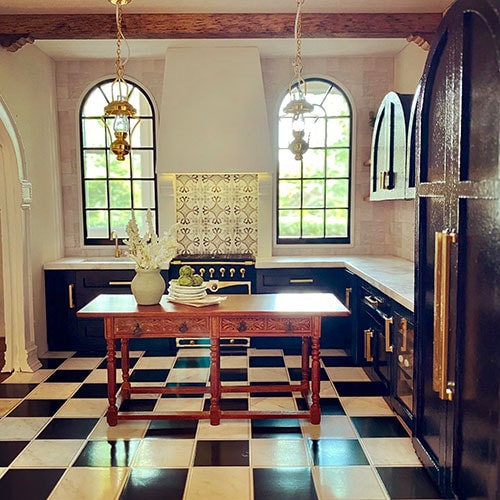
At first glance, it’s hard to believe that this kitchen would be better suited for dolls than people. But at just ten inches tall, that’s certainly the case.
“My house designs start with the kitchen. They are my favorite rooms [to design],” Roberts, an ob/gyn, interior designer, entrepreneur, and mother of two from the suburbs of Philadelphia, says. “I have to get these ideas out of my head or it drives me nuts.”
To maintain her sanity, Roberts has designed dream kitchens (and more) for a variety of plastic families in dollhouses of all styles over the last six years. Tiny House Calls, her miniature interior design business, is a cheeky reference to her dual specialties.
The New Mini Marketplace
Roberts is an unlikely member of the thriving miniature movement. The “Mini-Aissance,” a term coined by journalist and author Ronda Kaysen, describes the rapidly growing fascination with miniature model making. Once considered a niche hobby, it has now gone mainstream thanks to social media. Micro-influencers like Roberts boast devoted followings in the tens of thousands (her Instagram account, @tinyhousecalls, has over 87,000 followers).
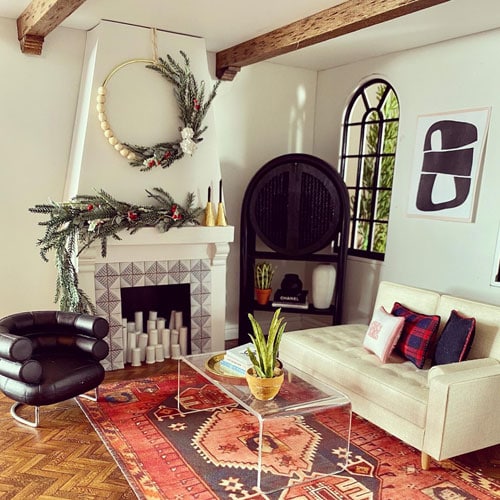
This tiny living room comes complete with mantle swags, a Lucite coffee table, and even thimble-sized snake plants.
Beyond Instagram, mini creators run thriving shops on Etsy and eBay, selling handmade and 3D-printed mantelpieces, Eames chairs, tiny houseplants, and complete “tiny homes.” Some, like seller Chris Toledo (I Build Small Things on Instagram), make their living crafting impressively detailed dioramas and houses for jaw-dropping sums; Toledo’s structures range from $20,000 – $200,000.
With renewed interest in the diminutive, vintage wares by pioneering miniaturists like the late Mary Eccher, whose line of tiny foods and snack stands, Pannikins by M.E., was featured in The New York Times in 1992, remains in high demand on the retail sites: a singular strawberry shortcake by Eccher—the size of a quarter—lists for $35 on Etsy, while a “Hole in One” donut stand fetched more than $200 in an online auction.
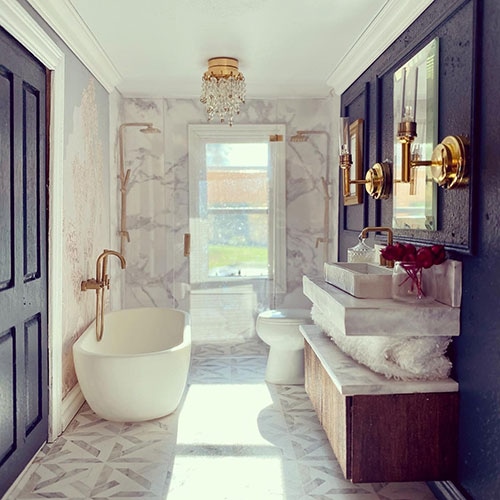
Roberts is one of many miniaturists reviving the art form. Here, the master bathroom in her Brownstone dollhouse features a glimmering chandelier and tasteful pattern mixing.
Originating in the 1500s, dollhouses began as curio cases, designed as displays for the petite treasures of their proprietors, known as “cabinet houses” in Holland. By the onset of the 18th century, these miniature manses, called “baby houses” in England and Germany, had morphed into scale models of the owner’s home — outfitted with miniature replicas of furnishings and art pieces found throughout the house. After becoming the playthings of children, thanks to the affordability of mass production in the 19th and 20th centuries, the dollhouse has reclaimed the imaginations of adult audiences with unexpected fervor — including that of Roberts.
How One Dollhouse Changed Her Life
“I bought my daughter a Melissa & Doug dollhouse for Christmas,” she remembers. As a special surprise for her daughter, now 7, Roberts overhauled the home, papering walls, upholstering new furnishings, and adding working light fixtures. “I loved it,” she says of the creative process. “I would get up in the middle of the night and move pieces around.”
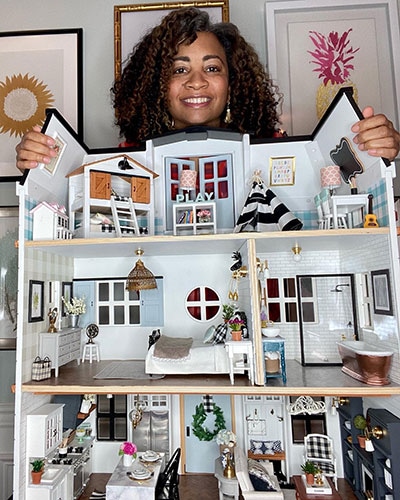
What started as a Christmas present for her daughter ended up changing Roberts’ life.
With over 20 years of private practice and hospital work under her belt, Roberts, who harbored an interior design obsession, was in search of a new project after every square inch of her suburban home had been updated or renovated.
Deciding to practice her design skills on a smaller scale, Roberts took a trip to Target. “I got a Fixer Upper dollhouse when Chip and Joanna Gaines’ Hearth & Hand collection was new, and people were talking about it like it was the second coming,” laughs Roberts of the three-story home outfitted with a soaking tub, bookcases, and shiplap exterior she refurbished with paint and custom furnishings, including a barn-themed bunkbed inspired by a piece Chip Gaines designed on Gaines’ hit HGTV show, “Fixer Upper”.
Roughly 160 hours of labor and $1000 later, Roberts photographed the house and proudly showed it to her coworkers who mistook it for Roberts’ actual home. The photographs appeared so realistic that receptionist Cheryl Benvignati urged Roberts to post the dollhouse project on Instagram. “It was my 45th birthday,” Roberts recalls. “I joined Instagram and shared it with my Facebook friends.”
To her shock, the farmhouse was received with adulation. “By the end of the week, the house had gone viral, and I got so many Facebook notifications [that] my phone froze. By the second week, Good Morning America and Disney were contacting me,” says Roberts. “I was in a patient room doing an exam, with the patient in stirrups, and Cheryl [my receptionist] knocked on the door saying, ‘Dr Roberts, The Today Show is on the phone.'”
“It was madness,” Roberts says of the rapid fame her Hearth & Hand dollhouse achieved, eventually garnering praise from the patron saint of farmhouse style, Joanna Gaines.
Fans were so impressed with her design that they began asking for interior design consultations for their homes, prompting Roberts to pursue the interior design education she craved. “I went back to interior design school, got certified, and started a design business.”

The foyer of this Cape May, NJ-inspired beach cottage draws on the tones one would find on a sunny shore, including pale blue and golden ochre.
But managing her thriving ob/gyn practice, motherhood, nonstop press requests, dollhouse projects, and bourgeoning design business (affectionately named House Call Designs) proved taxing. “I felt these [design] opportunities were once in a lifetime, and I knew I couldn’t do them while working,” says Roberts, who chose to leave her private practice behind and pursue Tiny House Calls full-time. “When I stepped back in January 2020, our CEO thought I was having a nervous breakdown,” says Roberts. “It sounded crazy — a doctor leaving private practice to design dollhouses.”
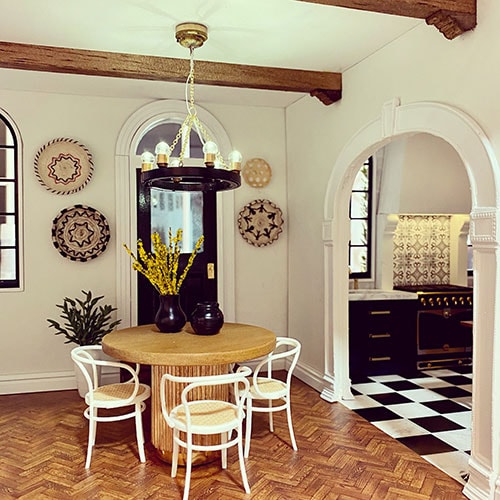
The sitting room just off the kitchen of her Spanish Colonial-style dollhouse features a herringbone-patterned wood floor and miniature decorative baskets.
Pursuing her passion proved immediately rewarding. With eight completed dollhouses and another eight in progress, Roberts finds herself in a steady media frenzy. “Every time I think it’s going to die down, it never does,” Roberts says. Parents magazine, Country Living, and The New York Times have featured her miniatures, and, to Roberts’s elation, in 2020, HGTV offered her a television spot. “I was a designer on an episode of an HGTV show called ‘Sell This House.’ It was a full-circle moment for me to do television and design,” she says.
Tiny Design, Big Impact
Although her time away from medicine has been restorative and unexpectedly rewarding (she works a few days each month as a laborist at Holy Redeemer Hospital to maintain her certifications), Roberts admits the transition was tough. “It was hard for me. [As a doctor,] you are taking care of people, and I think it’s hard to step back from that,” she says. “But I want people to know you can step back and take care of yourself.”
To spread this message of creative healing further, Roberts has a television show and American-made dollhouse furniture collection in the works, meaning her schedule is never quite free enough to realize each kitchen and bedroom design her inspired mind envisions. And though the list of dream dollhouse creations grows, the encouragement her work brings others propels her towards her goals: “I am bringing people joy, and I am going to focus on that.”
For more news, follow Medscape on Facebook, Twitter, Instagram, YouTube, and LinkedIn
Source: Read Full Article
